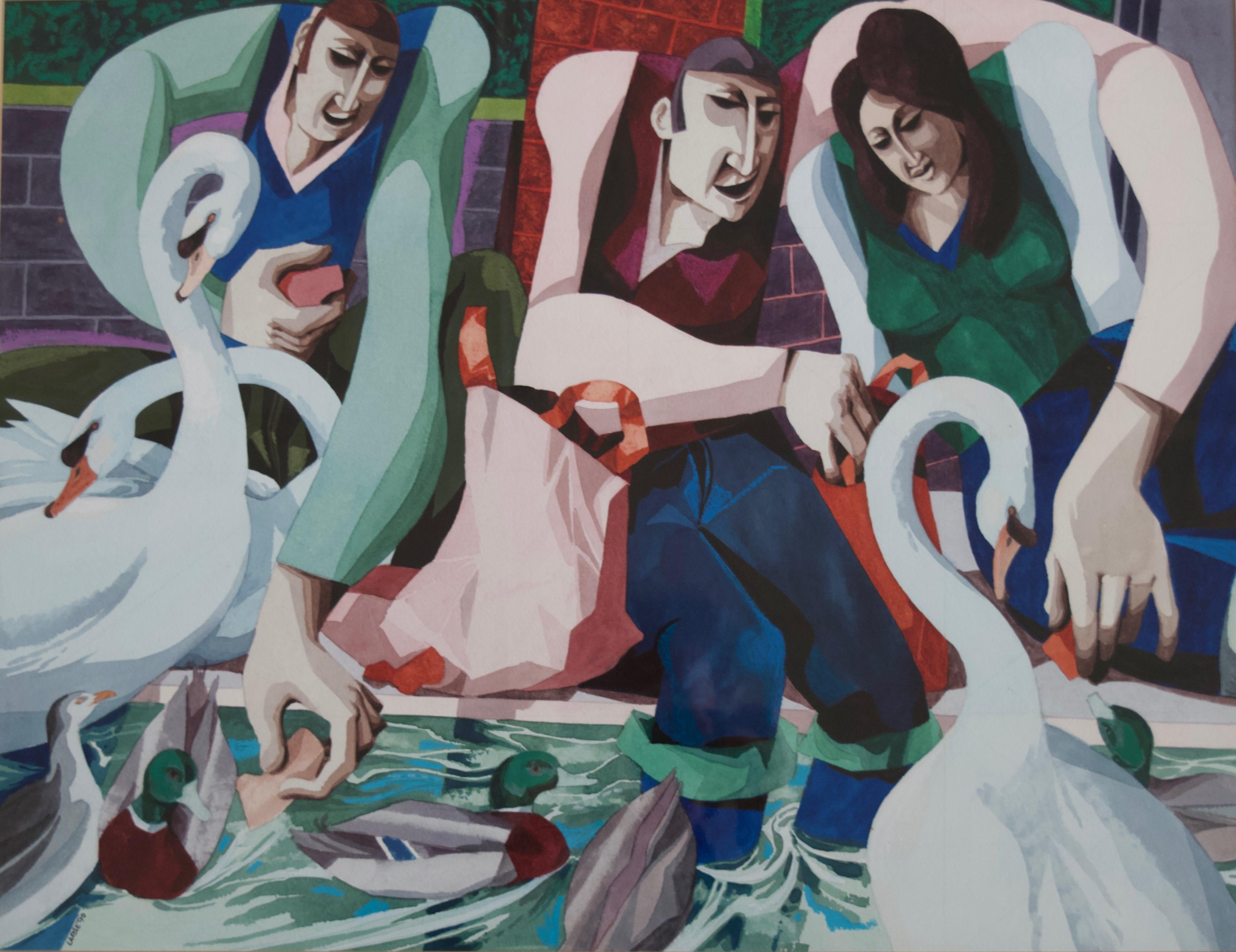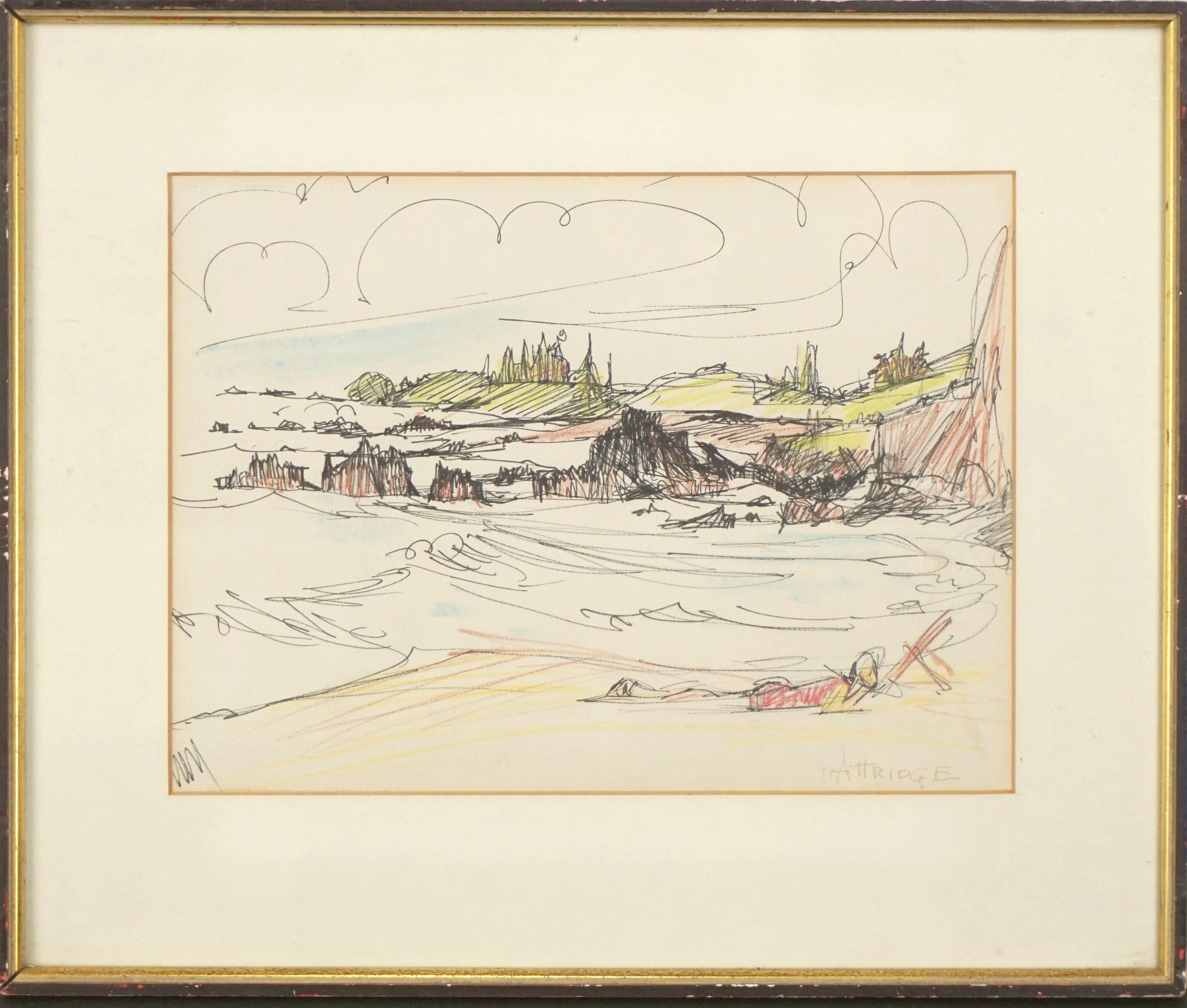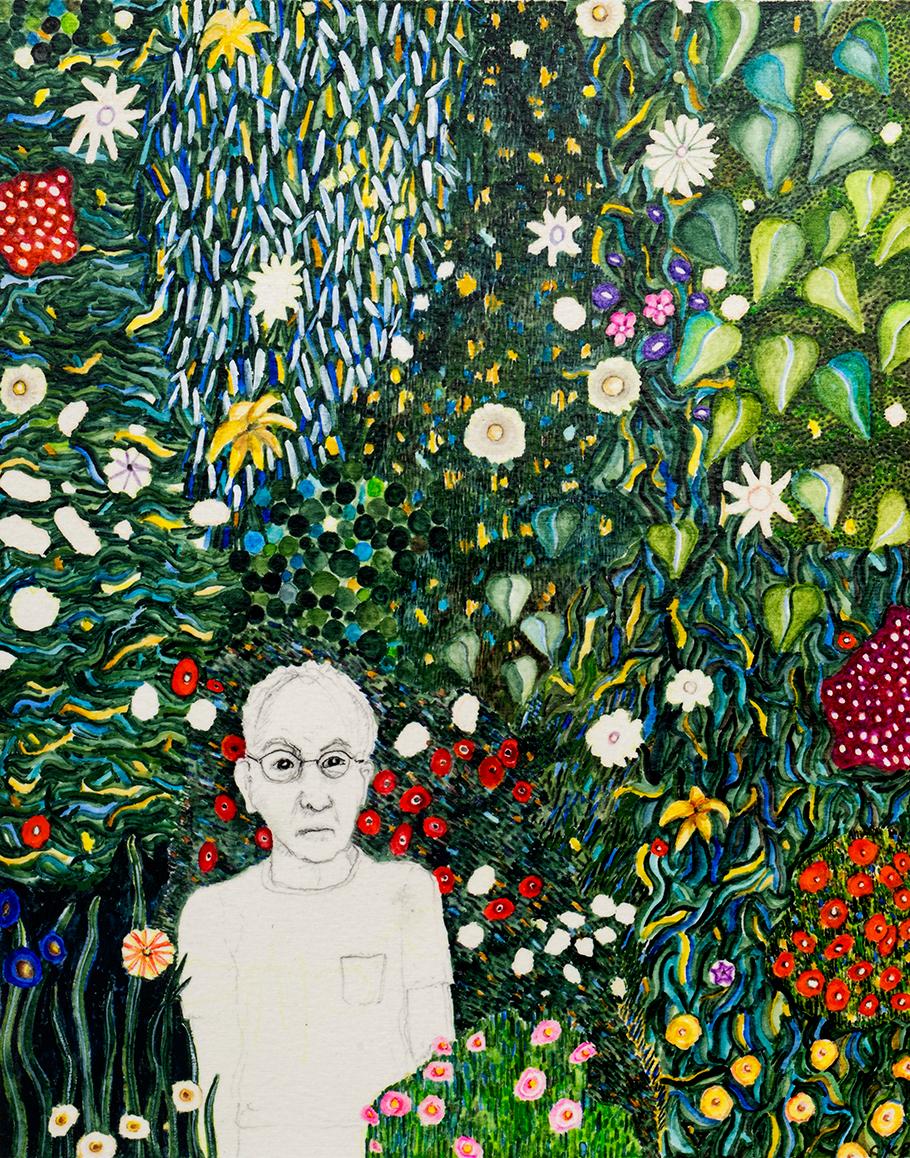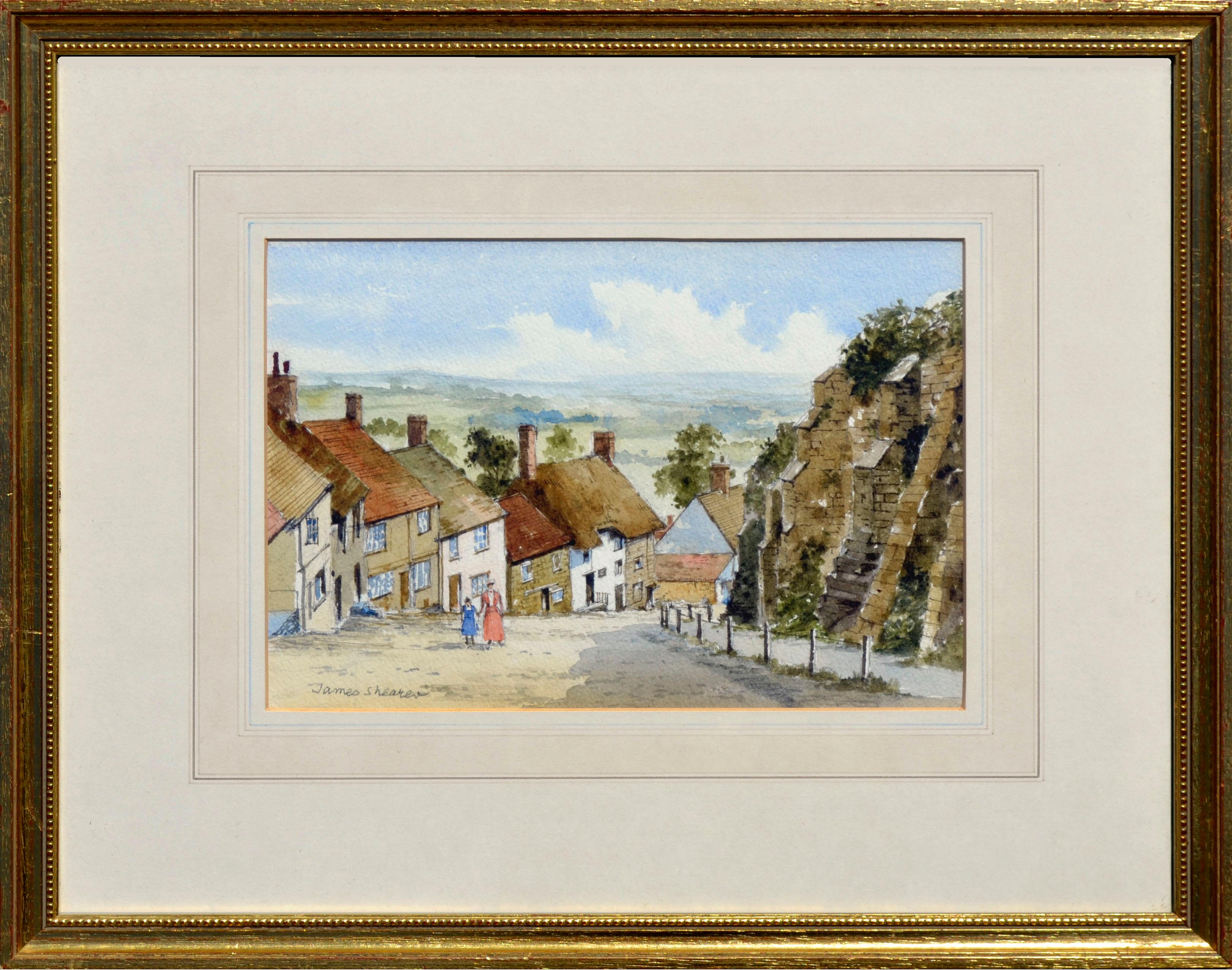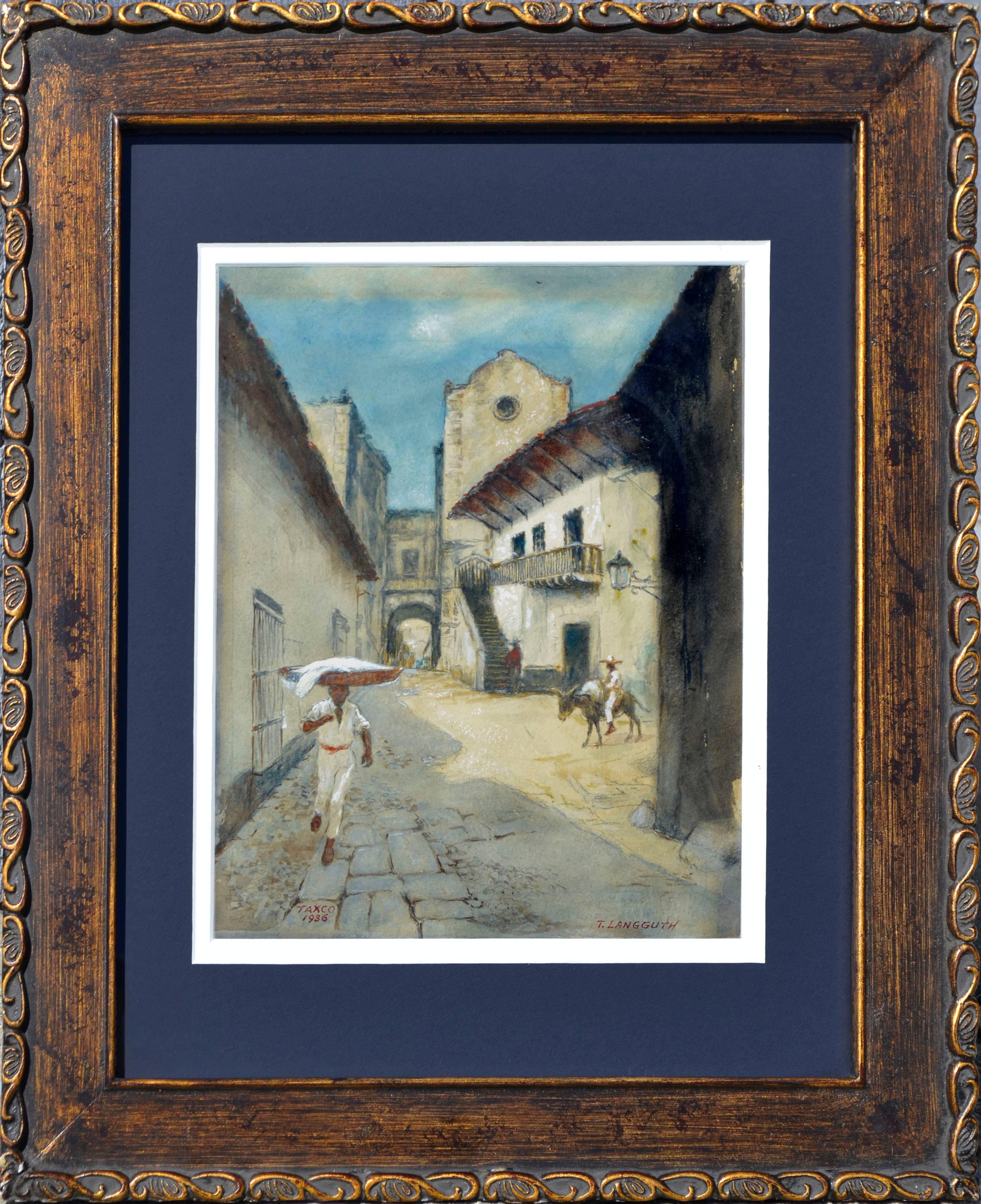Items Similar to George Large, Street Musicians, Cubist art
Want more images or videos?
Request additional images or videos from the seller
1 of 9
George LargeGeorge Large, Street Musicians, Cubist art1991
1991
About the Item
***Please note the glass will be removed for shipping***
For local and London deliveries the glass can be retained if agreed prior to purchase.
George Large, R.I. (born 1936)
Street musicians
Signed and dated (19)91
Watercolour over traces of pencil
15¾ x 26
25½ x 35 with frame
George Large is a painter in watercolour and oil, born in Islington, London in 1936. He studied at Hornsey College of Art (1958-63), teachers including Maurice de Sausmarez, John Titchell and Alfred Daniels. Large spent some time in the display department of Simpson’s, Piccadilly, was part-time at Hornsey College of Art, then head of department at St Julian Comprehensive School in St Albans. Large showed 1963-87 with SWE, being vice-president in 1972 and treasurer in 1984; with RE, 1963-5; with RI from 1983, becoming a member in 1986 and its archivist; and was also made a member of the RBA in 1997. Large was winner of the Windor & Newton award, 1989; he won the Llewellyn Alexander and St Cuthbert’s Mill Awards in 1999; and the Arts Club Award in 2003. He had a solo show at Mall Galleries in 1980, later one-man exhibitions including Duncan Campbell Fine Art from 1990. In 2000, Goldmark Gallery, Uppingham, showed Large’s work, at the same time releasing its documentary film on him, Trust Me I’m An Artist. There were further Goldmark George Large exhibition in 2003 and 2015. Human figures are important components in Large’s compositions, often men at work, and the work of Edward Burra and Stanley Spencer has been influential upon Large’s art. It is an easily recognizable, colourful form of Cubism. Large completed a mural for British Rail for the King’s Cross Thameslink Station. In recent years Large has lived and painted in Rutland and Malta, and his work is held in important public and private collections including National Gallery and British Consulate in Malta.
Source: The Royal Institute of Painters in Water Colours website
- Creator:George Large (1936)
- Creation Year:1991
- Dimensions:Height: 15.75 in (40.01 cm)Width: 26 in (66.04 cm)Depth: 1.5 in (3.81 cm)
- Medium:
- Movement & Style:
- Period:
- Condition:
- Gallery Location:Harkstead, GB
- Reference Number:1stDibs: LU148128523042
About the Seller
5.0
Platinum Seller
These expertly vetted sellers are 1stDibs' most experienced sellers and are rated highest by our customers.
Established in 2002
1stDibs seller since 2021
98 sales on 1stDibs
Typical response time: 1 hour
- ShippingRetrieving quote...Ships From: Harkstead, United Kingdom
- Return PolicyA return for this item may be initiated within 7 days of delivery.
More From This SellerView All
- George Large, Feeding the swans, Cubist artBy George LargeLocated in Harkstead, GB***Please note the glass will be removed for shipping*** For local and London deliveries the glass can be retained if agreed prior to purchase. George Large, R.I. (born 1936) Feeding the swans...Category
Late 20th Century Modern Figurative Paintings
MaterialsPaper, Watercolor, Pencil
- George Large, The Fungi Collectors, Cubist artBy George LargeLocated in Harkstead, GB***Please note the glass will be removed for shipping*** For local and London deliveries the glass can be retained if agreed prior to purchase. George Large, R.I. (born 1936) Edible Fungi Signed and dated (19)91 Watercolour over traces of pencil 26¾ x 14¾ 37 x 24½ with frame George Large is a painter in watercolour and oil, born in Islington, London in 1936. He studied at Hornsey College of Art (1958-63), teachers including Maurice de Sausmarez, John Titchell and Alfred Daniels. Large spent some time in the display department of Simpson’s, Piccadilly, was part-time at Hornsey College of Art, then head of department at St Julian...Category
Late 20th Century Modern Figurative Paintings
MaterialsPaper, Watercolor, Pencil
- Gerald Gardiner, Harvesting scene with rainbowLocated in Harkstead, GBA bucolic scene at harvesting time Gerald Gardiner (1902-1959) Harvesting time Signed and dated 1944 Oil on paper 10½ x 15¾ inches Landscape painter ...Category
Mid-20th Century Impressionist Landscape Paintings
MaterialsOil, Paper, Oil Pastel
- Paul Madeline, Impressionist summer garden sceneBy Paul MadelineLocated in Harkstead, GBA really beautiful example of Post-Impressionist painting; the picture space filled with light and wonderfully free brushwork. A most attractive rustic image presented in very good o...Category
Late 19th Century Post-Impressionist Landscape Paintings
MaterialsCanvas, Oil
- Circle of Chaïm Soutine, Expressionist painting of Fishermen in a French harbourLocated in Harkstead, GBA very stylish image of a French harbour. Painted with great panache - wonderful brushwork and a vivid palette, reminiscent of the work of Chaim Soutine Circle of Chaïm Soutine (189...Category
20th Century Expressionist Landscape Paintings
MaterialsBoard, Oil
- Victorian landscape painting of Scottish fishing boats moored in a bayLocated in Harkstead, GBA very tranquil scene of fishing boats moored in harbour with a sunlit sea beyond. Painted with a most attractive palette of blues and greens and with a pleasing composition that le...Category
19th Century Victorian Landscape Paintings
MaterialsOil, Canvas
You May Also Like
- Mid Century Modern Mixed Media Painting -- Day at the BeachLocated in Soquel, CAWonderful mid century mixed media coastal/figurative in loose/painterly style by Irmal Gertrude Attridge (American, 1894-1962), circa 1950. Signed lower right. Presented in vintage frame under glass (included as-is). Image size: 9"H x 12"W. Irma Gertrude Attridge was born in Chicago and studied at Chouinard Art Institute in Los Angeles with Henry McFee and Oscar Van Young. Member of Calif. AC; AEA; Cal. WC. Soc.; Women Painters...Category
1950s Modern Landscape Paintings
MaterialsInk, Watercolor, Color Pencil
- NEARBYBy Carol K. BrownLocated in New York, NYThe artist is dealing with the fullness of life, while the ground becomes shakier. There is nostalgia for a lush world that never actually existed. Her lighthearted series of drawing...Category
2010s Contemporary Landscape Paintings
MaterialsInk, Paper, Watercolor, Photographic Paper, Graphite
- Shaftesbury England, Figurative LandscapeBy James ShearerLocated in Soquel, CAFigurative landscape of Shaftesbury, Dorset, England by James Shearer (English, 20th Century). Presented in a giltwood frame. Signed "James Shearer" lower left. Titled "Shaftesbury D...Category
1970s Impressionist Landscape Paintings
MaterialsPaper, Watercolor, Pencil
- Taxco, Mexico - 1930's Figurative Village LandscapeBy Theodore Ernest LangguthLocated in Soquel, CAA vintage watercolor capturing a daily scene in the Spanish colonial town of Taxco, Mexico by Theodore Ernest Langguth (German-American, 1861-1952). Titled, dated and signed lower ma...Category
1930s American Impressionist Landscape Paintings
MaterialsPaper, Watercolor, Gouache, Pencil
- Society of Six Street Scene - Figurative AbstractBy Bernard Von EichmanLocated in Soquel, CAStunning New York City urban modernist watercolor titled "Summer Afternoon Stroll" by Society of Six artist Bernard Von Eichman (American, 1899-1990), 1...Category
1930s American Modern Landscape Paintings
MaterialsArchival Paper, Watercolor
- Golden Cycle Mill, Colorado, 1940s WPA Mining Watercolor Landscape, Black WhiteBy Charles Ragland BunnellLocated in Denver, COOriginal 1940s watercolor on paper painting by Charles Ragland Bunnell portraying a semi abstracted view of Golden Cycle Mill in Colorado Springs, Colorado. Painted in shades of black and gray. Presented in a custom black frame, outer dimensions measure 18 x 19 ½ x 1 ⅜ inches. Image sight size is 8 ⅛ x 9 ⅝ inches. Golden Cycle Mining and Reduction Company was a mining company in Colorado City (now Old Colorado City) in El Paso County, Colorado. Piece is clean and in excellent condition - please contact us for a detailed condition report. Expedited and international shipping is available - please contact us for a quote. About the artist: Artist and teacher, Charles (“Charlie”) Bunnell worked in a variety of styles throughout his career because as an artist he believed, “I’ve got to paint a thousand different ways. I don’t paint any one way.” At different times he did representational landscapes while concurrently involved with semi- or completely abstract imagery. He was one of a relatively small number of artists in Colorado successfully incorporating into their work the new trends emanating from New York and Europe after World War II. During his lifetime he generally did not attract a great deal of critical attention from museums, critics and academia. However, he personally experienced a highpoint in his career when Katherine Kuh, curator at the Art Institute of Chicago, personally chose one of his paintings – Why? - for its large exhibition of several hundred examples of abstract and surrealist art held in 1947-48, subsequently including it among the fifty pieces selected for a traveling show to ten other American museums. An only child, Bunnell developed his love of art at a young age through frequent drawing and political cartooning. In high school he was interested in baseball and golf and also was the tennis champion for Westport High School in Kansas City. Following graduation, his father moved the family to Denver, Colorado, in 1916 for a better-paying bookkeeping job, before relocating the following year to Colorado Springs to work for local businessman, Edmond C. van Diest, President of the Western Public Service Company and the Colorado Concrete Company. Bunnell would spend almost all of his adult life in Colorado Springs. In 1918 he enlisted in the United States Army, serving in the 62nd Infantry Regiment through the end of World War I. Returning home with a 10% disability, he joined the Zebulon Pike Post No. 1 of the Disabled American Veterans Association and in 1921 used the benefits from his disability to attend a class in commercial art design conducted under a government program in Colorado Springs. The following year he transferred to the Broadmoor Art Academy (founded in 1919) where he studied with William Potter and in 1923 with Birger Sandzén. Sandzén’s influence is reflected in Bunnell’s untitled Colorado landscape (1925) with a bright blue-rose palette. For several years thereafter Bunnell worked independently until returning to the Broadmoor Art Academy to study in 1927-28 with Ernest Lawson, who previously taught at the Kansas City Art Institute where Bunnell himself later taught in the summers of 1929-1930 and in 1940-41. Lawson, a landscapist and colorist, was known for his early twentieth-century connection with “The Eight” in New York, a group of forward-looking painters including Robert Henri and John Sloan whose subject matter combined a modernist style with urban-based realism. Bunnell, who won first-place awards in Lawson’s landscapes classes at the Academy, was promoted to his assistant instructor for the figure classes in the 1928-29 winter term. Lawson, who painted in what New York critic James Huneker termed a “crushed jewel” technique, enjoyed additional recognition as a member of the Committee on Foreign Exhibits that helped organize the landmark New York Armory Exhibition in 1913 in which Lawson showed and which introduced European avant-garde art to the American public. As noted in his 1964 interview for the Archives of American Art in Washington, DC, Bunnell learned the most about his teacher’s use of color by talking with him about it over Scotch as his assistant instructor. “Believe me,” Bunnell later said, “[Ernie] knew color, one of the few Americans that did.” His association with Lawson resulted in local scenes of Pikes Peak, Eleven Mile Canyon, the Gold Cycle Mine near Colorado City and other similar sites, employing built up pigments that allowed the surfaces of his canvases to shimmer with color and light. (Eleven Mile Canyon was shown in the annual juried show at the Carnegie Institute in Pittsburgh in 1928, an early recognition of his talent outside of Colorado.) At the same time, he animated his scenes of Colorado Springs locales by defining the image shapes with color and line as demonstrated in Contrasts (1929). Included in the Midwestern Artists’ Exhibition in Kansas City in 1929, it earned him the gold medal of the Kansas City Art Institute, auguring his career as a professional artist. In the 1930s Bunnell used the oil, watercolor and lithography media to create a mini-genre of Colorado’s old mining towns and mills, subject matter spurned by many local artists at the time in favor of grand mountain scenery. In contrast to his earlier images, these newer ones – both daytime and nocturnal -- such as Blue Bird Mine essentially are form studies. The conical, square and rectangular shapes of the buildings and other structures are placed in the stark, undulating terrain of the mountains and valleys devoid of any vegetation or human presence. In the mid-1930s he also used the same approach in his monochromatic lithographs titled Evolution, Late Evening, K.C. (Kansas City) and The Mill, continuing it into the next decade with his oil painting, Pikes Peak (1942). During the early 1930s he studied for a time with Boardman Robinson, director of the Broadmoor Art Academy and its successor institution, the Colorado Springs Fine Arts Center from 1930 to 1947. In 1934 Robinson gave him the mural commission under the Public Works of Art Project (PWAP) for West Junior High School in Colorado Springs, his first involvement in one of several New Deal art...Category
1940s American Modern Landscape Paintings
MaterialsPaper, Watercolor
